
©2015 Universal Forest Products, Inc. All rights reserved.
68956 U.S. Hwy 131, White Pigeon, MI 49099 616.365.4201 8574_11/15
www.ufpi.com
A general rule of thumb is to place 1/3 of the post into the ground.
Check local regulations for any special requirements. The fence
will be stronger if the end, corner and gate posts are set at least
6" deeper than the line posts. Using a posthole digger or power
auger, dig the holes 10-12" wide and 6" deeper than needed.
Backfill the holes with 6" of gravel to drain water away from the
bottom of the posts (fig. 1). Keep the height of your fence panels
in mind when digging your postholes.
Starting in the corner, mix concrete in the first hole per the
instructions on the bag. Mix thoroughly and install the post into
the hole and tap the post to
the proper depth. We rec-
ommend a 2” gap from the
ground to the bottom of the
panel. Use a level to ensure
the fence post is plumb
and the post is square with
the ground. Brace the post
with temporary supports as
the concrete sets (per the
instructions).
Check local ordinances and regulations before building your
fence. Before construction, contact your local utility companies
to mark any underground cables and pipelines. In addition, it is
a good idea to discuss plans with any neighbors along your
proposed fence line.
Step 3Preparation
Digging postholes
• Determine the number of posts, panels and gates needed to
complete the job based on the total linear footage. Take into
consideration post, panel and gate widths when determining
the total number of each.
• Adjust layout to accommodate as many full panels as possible.
If you must use a partial panel, place it in the farthest rear
corner of the property.
• Locate property boundaries and drive stakes into the ground
at corners and ends of fence line, based on local municipality
regulations.
• Stretch twine or heavy string between stakes and pull tight
to mark layout of fence line.
• Be sure to measure your fence panels and gates prior to
determining the location of the postholes. Place posts in the
following order along string line:
• End/corner posts • Gate posts • Line posts
Design and layout
36" to 42"
10" to 12"
Diameter
Level
Fig.4.pdf
fig. 1
Items you may need
• Fence posts*
• Posthole digger
• Measuring tape
• Clear PVC cement
• Drill
• Screwdriver
• Level
• Chop saw
• String line
• Concrete
• Gravel
• Shims
• Pencil
• Safety glasses
• Gloves
* One per panel, plus
one to complete the
fence run.
Kit Contents
• 8 — Pickets
• 2 — U-channels
• 2 — Rails
• 8 — Screws
6x6 OVERLAND PRIVACY PANEL
ASSEMBLY INSTRUCTIONS
Horizontal
OverlandFenceAsm.ai
Vertical
Vertical
Horizontal
Horizontal
OverlandFenceAsm.ai
Vertical
Vertical
Horizontal
Actual panel size: 63" W x 69-3/4" H

©2015 Universal Forest Products, Inc. All rights reserved.
68956 U.S. Hwy 131, White Pigeon, MI 49099 616.365.4201 8574_11/15
www.ufpi.com
Assembling the panel
STEP 1
Install first post with concrete (“Digging postholes” and fig. 1).
STEP 2
Slide the bottom rail into place at the bottom of the routed
post (fig. 2).
STEP 3
With the bottom rail placed, secure a U-channel to the center of
the post using the provide screws. The U-channel needs to sit
above the bottom rail. Set a screw every 20 inches (fig. 3).
STEP 4
Install the second post into the ground and temporarily secure
into place. Set the bottom rail into the second post and level.
(You will secure it with concrete in Step 6.)
Repeat Step 3 to secure a U-channel to the second post (fig. 4).
STEP 5
To build a panel with horizontal pickets:
Slide the first picket into the U-channels so that it’s parallel to the
bottom rail. Secure it into the channel of the bottom rail. Continue
installing each picket. The pickets feature a tongue-and-groove
design so that each picket fits securely into the one below it. Re-
peat with each picket until panel is complete (fig 5).
To build a panel with vertical pickets:
Slide the first picket into one U-channel so that it’s perpendicular
to the bottom rail. Slide the bottom of the picket securely into the
channel of the bottom rail. Continue installing each picket. The
pickets feature a tongue-and-groove design so that each picket
fits securely into the one next to it. Repeat with each picket until
panel is complete (fig 5).
STEP 6
When all pickets have been placed, secure the top rail to the top
routed hole in the first post. Working from one side to the other,
slide the rail over the picket(s). In order to fasten the rail into the
second post, shift the post slightly until the rail can be fitted. Once
the rail is securely locked in, the pickets will form a solid panel.
Backfill the second post with concrete and make sure it’s set
before moving down the fence line. This will always allow one post
to be anchored while each panel section is assembled (fig. 6). To
continue building your fence line, repeat Steps 1-6.
OverlandStep1.ai
OverlandStep3.ai
fig. 2
fig. 3
6x6 OVERLAND PRIVACY PANEL ASSEMBLY INSTRUCTIONS
OverlandStep4.ai
Horizontal
OverlandStep5.ai
Vertical
OverlandStep6.ai
fig. 4
fig. 5
fig. 6

©2015 Universal Forest Products, Inc. Todos los derechos reservados.
68956 U.S. Hwy 131, White Pigeon, MI 49099 616.365.4201 8574_12/15
www.ufpi.com
Una regla general es enterrar 1/3 del poste. Verifique si las regula-
ciones locales marcan algún requerimiento especial. La cerca será
más sólida si los postes terminales, de esquinas y de puertas se
colocan al menos 15.2 cm (6 pulg.) más profundos que los postes de
línea. Utilizando una excavadora de postes o un barreno motorizado
excave los agujeros de 25.4 a 30.5 cm (10 a 12 pulg.) de diámetro y
15.2 cm (6 pulg.) más profundos de lo necesario. Rellene los agujeros
con 15.2 cm (6 pulg.) de grava para drenar agua de la base de los
postes (fig. 1). Tenga en mente la altura de sus paneles de cerca al
excavar sus agujeros para postes.
poste con soportes temporales mientras el concreto seca (de acuerdo
con las instrucciones).
Comenzando en la esquina,
mezcle concreto en el primer
agujero siguiendo las instruc-
ciones de la bolsa. Mezcle com-
pletamente e instale el poste
dentro del agujero, entierre
el poste hasta la profundidad
apropiada: Recomendamos
dejar un espacio de 5.1 cm (2
pulg.) desde el suelo hasta la
parte inferior del panel. Use un
nivel para asegurarse de que el
poste de la cerca está recto y
perpendicular al piso. Sujete el
Revise las ordenanzas y regulaciones locales antes de instalar su
cerca. Antes de iniciar la construcción, contacte a las compañías de
servicios públicos locales para identificar la presencia de cualquier
cable o tubería subterránea. Además, es una buena idea hablar sobre
sus planes con cualquier vecino que vaya a estar en la línea en la que
piensa instalar su cerca.
Step 3Preparación
36" to 42"
10" to 12"
Diameter
Level
Fig.4.pdf
fig. 1
Excavación de agujeros para postes
• Determine la cantidad de postes, paneles y puertas necesarios para
completar el trabajo con base en la distancia lineal total. Considere
la anchura de los postes, paneles y puertas al determinar la cantidad
total de cada uno.
• Ajuste la disposición para utilizar la mayor cantidad posible de
paneles completos. Si debe usar un panel parcial, colóquelo en
el rincón más oculto de la propiedad.
• Ubique los límites de la propiedad y coloque estacas en el suelo en
las esquinas y extremos de la cerca, con base en las regulaciones
municipales locales.
• Tienda una cuerda o cordón grueso entre las estacas y estírelo
para marcar la disposición de la cerca.
• Asegúrese de medir sus paneles de cerca y puertas antes de
determinar la ubicación de los agujeros para los postes. Coloque
los postes en el siguiente orden a lo largo de la línea marcada por
el cordón.
• Postes terminales o de esquinas • Postes de puerta
• Postes de línea
Diseño y disposición
Artículos que puede necesitar:
• Postes para cerca*
• Excavadora para
postes
• Cinta de medir
• Cemento claro
para PVC
• Taladro
• Destornillador
• Nivel
• Sierra ingletadora
• Cordel para marcar
• Concreto
• Grava
• Cuñas
• Lápiz
• Lentes de
seguridad
• Guantes
*Uno por panel, más
uno para terminar el
tramo de cerca.
Contenido del kit
• 8 — Tablones
• 2 — Canales en U
• 2 — Rieles
• 8 — Tornillos
PANEL DE PRIVACIDAD OVERLAND
DE 1.83x1.83 m (6X6)
INSTRUCCIONES DE ARMADO
Horizontal
OverlandFenceAsm.ai
Vertical
Vertical
Horizontal
con
Horizontal
OverlandFenceAsm.ai
Vertical
Vertical
Horizontal
Tamaño real: 63" de ancho x 69-3/4" de alto
Nivel
25.4 a 30.5 cm
(10 a 12 pulg.)
de diámetro
91.4 a 106.7 cm
(36 a 42 pulg.)

©2015 Universal Forest Products, Inc. Todos los derechos reservados.
68956 U.S. Hwy 131, White Pigeon, MI 49099 616.365.4201 8574_12/15
www.ufpi.com
Armado del panel
PASO 1
Instale el primer poste con concreto (“Excavación de agujeros
para postes” y fig. 1).
PASO 2
Deslice el riel inferior en su sitio en la parte inferior del poste
ranurado (fig. 2).
PASO 3
Después de colocar el riel inferior, sujete un canal en U al centro
del poste usando los tornillos incluidos. El canal en U debe
quedar encima del riel inferior. Coloque un tornillo cada 50.8 cm
(20 pulg.) (fig. 3).
PASO 4
Instale el segundo poste en el piso y sujételo temporalmente
en su sitio. Sujete el riel inferior al segundo poste y nivélelo.
(Lo sujetará con concreto en el Paso 6).
Repita el Paso 3 para sujetar un canal en U al segundo poste (fig. 4).
PASO 5
Para armar un panel con tablones horizontales:
Deslice el primer tablón en los canales en U de modo que quede
paralelo al riel inferior. Sujételo en el canal del riel inferior. Siga
instalando cada tablón. Los tablones tienen un diseño de lengüeta
y ranura, de modo que cada uno encaja con el que está debajo.
Repita con cada tablón hasta que el panel esté terminado (fig. 5).
Para armar un panel con tablones verticales:
Deslice el primer tablón en un canal en U de modo que quede
perpendicular al riel inferior. Deslice la parte inferior del tablón
dentro del canal del riel inferior. Siga instalando cada tablón. Los
tablones tienen un diseño de lengüeta y ranura, de modo que cada
uno encaja con el que está al lado. Repita con cada tablón hasta
que el panel esté terminado (fig. 5).
PASO 6
Después de colocar todos los tablones, sujete el riel superior al
agujero superior del primer poste. Trabajando de lado a lado,
deslice el riel sobre los tablones. Para sujetar el riel al segundo
poste, mueva el poste ligeramente hasta que pueda ajustar el riel.
Una vez que el riel quede bien sujeto, los tablones formarán un
panel sólido.
Rellene el agujero del segundo poste con concreto y asegúrese
de que está seco antes de continuar con la cerca. De este modo
siempre habrá un poste anclado mientras arma una sección de
panel (fig. 6). Para seguir construyendo su cerca, repita los pasos
1 a 6.
OverlandStep1.ai
OverlandStep3.ai
fig. 2
fig. 3
PANEL DE PRIVACIDAD OVERLAND DE 1.83x1.83 m (6X6) INSTRUCCIONES DE ARMADO
OverlandStep4.ai
Horizontal
OverlandStep5.ai
Vertical
OverlandStep6.ai
fig. 4
fig. 5
fig. 6
-
 1
1
-
 2
2
-
 3
3
-
 4
4
Veranda 240149 Instrucciones de operación
- Tipo
- Instrucciones de operación
- Este manual también es adecuado para
En otros idiomas
Documentos relacionados
-
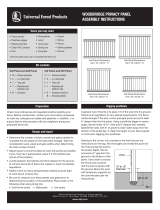 Veranda 246062 Guía de instalación
Veranda 246062 Guía de instalación
-
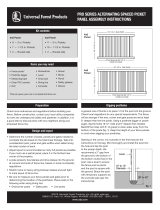 Veranda 128017 Guía de instalación
Veranda 128017 Guía de instalación
-
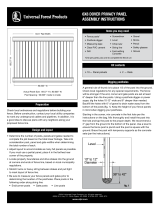 Veranda 141569 Instrucciones de operación
Veranda 141569 Instrucciones de operación
-
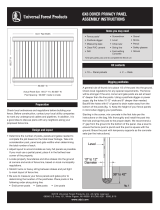 Veranda 141568 Guía de instalación
Veranda 141568 Guía de instalación
-
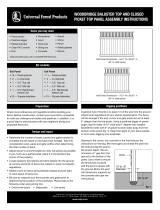 Veranda 144727 Instrucciones de operación
Veranda 144727 Instrucciones de operación
-
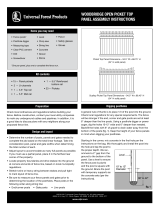 Veranda 144731 Instrucciones de operación
Veranda 144731 Instrucciones de operación
-
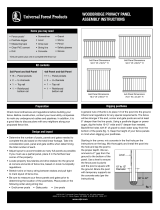 Veranda 144729 Instrucciones de operación
Veranda 144729 Instrucciones de operación
-
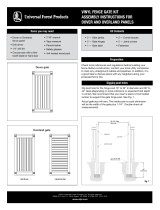 Veranda 144205 Instrucciones de operación
Veranda 144205 Instrucciones de operación
-
Outdoor Essentials 53990 Guía de instalación
-
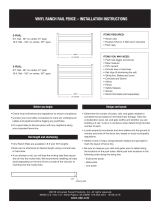 Veranda 53990 Guía de instalación
Veranda 53990 Guía de instalación













